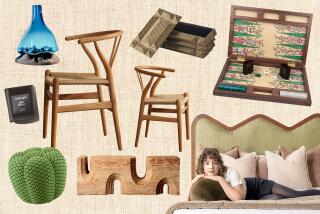DECORATING : Rusty and Rustic : Tin--Malleable and Lightweight--Is Ideal for Creative Accents in Many Decors
- Share via
When people think of tin, they usually think of tin cans, tin buckets or, if they remember “The Wizard of Oz,” the Tin Man.
They don’t think of tin, that humblest of metals, as a trendy material for home interiors. Yet when it comes to home decorating, tin is increasingly popular.
Interior designers and artisans are finding the lightweight, malleable and inexpensive metal to be an ideal medium for many kinds of accent pieces.
Tin is being used for lampshades, candlesticks, light switch plates, mirror frames, wall sconces, sculptures and other accessories.
Many home decorators don’t recognize that the charmingly weathered and rustic frames or lampshades they’re seeing in interior design stores are actually made from new sheets of tin. That’s because, rather than fight tin’s natural tendency to age less than gracefully, artisans are treating tin so that it already looks old.
Shiny, galvanized tin is still used for watering cans, service plates and other items for country interiors, but most tin accessories are treated with paints, acids and other chemicals to give them an antique look.
Rustic and rusty metal accents with a rough, hand-hewn texture can add a personal touch to Mediterranean, Southwest, Western and even contemporary decors.
“In the past antiques were used for individuality and character. Now these (tin pieces) are taking their place as unique things for the home,” says Colleen Wolf, an interior designer and manager of Santa Fe Savvy in Laguna Niguel. “(Artisans) are making high-end things out of these low-end materials.”
Other metals such as copper, iron and steel are also being used in new ways. Pieces such as iron floor lamps with tin shades, iron and glass coffee tables and rusty iron bed frames are all part of what Wolf calls the “rustic elegance” look.
Designer Joseph Franklin of Chula Vista makes lamps, lampshades, mirrors and other accessories out of copper and tin that he ages artificially.
“I studied ancient crafts and discovered the old tools and techniques were the best way to get the best looks,” Franklin says. “I’ve always been enchanted with artifacts and archeology.”
Franklin developed a primitive process to get aged finishes that he calls his “Earth Burial” technique.
“The metal sheet is buried under the earth . . . then we turn it into things,” he says.
His tools are primitive. He uses a club with a lot of sharp spikes sticking out to make the “wormholes” seen on many of his lamp shades.
Among his copper creations: a pyramid-shaped floor lamp with a shade covered in his tiny wormholes so light shines through ($856), a lampshade with a verde (green) finish ($150) or a verde Chimayo mirror ($736), all at Santa Fe Savvy.
Most tin pieces sold in the area are handmade by artisans in Mexico and New Mexico.
“In Mexico, tin has always been popular,” says Judy Rasmussen, interior designer and co-owner of Aztec Express in Costa Mesa. “Tin artifacts have always been used for religious articles in Mexico because they were shiny and inexpensive.”
Mexican artisans today often take the shine off tin. They paint it to look like more expensive metals, including pewter and copper, to give it a richer finish for decorating. They can also give tin the same greenish verdigris coating that forms on brass, copper and bronze.
“Tin has changed its face,” Rasmussen says. “It’s oxidized, it’s molded into shapes, it’s painted. It’s a great medium to work in because it’s soft.”
Using hand tools, the artisans pierce or pound out simple designs. Cacti, flowers, fish and mountain ranges are popular themes. The hand-crafted items appeal to homeowners searching for one-of-a-kind things.
Items at Aztec Express include a tin vase with verde finish ($40), a hand-pierced tin lampshade with a pewter finish by Franklin ($179), a 5-foot-tall bird cage ($750) and massive mirrors with tin frames, one embossed with a toucan motif ($1,495) and a round frame encircled with fish ($895).
While tin pieces can mix with a wide variety of decors, Wolf says there are some interiors where the metal looks out of its element.
“Tin accessories are inappropriate in really elegant formal rooms,” she says. “You can’t stick in a tin lampshade when the room calls for silk.”


